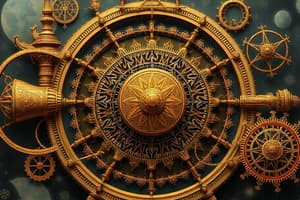Podcast
Questions and Answers
Which of the following is a characteristic of a wave?
Which of the following is a characteristic of a wave?
- Density
- Amplitude (correct)
- Mass
- Velocity
Which of the following is a phenomenon associated with the superposition of waves?
Which of the following is a phenomenon associated with the superposition of waves?
- Refraction
- Polarization
- Interference (correct)
- Reflection
Which of these equations represents the equivalence of mass and energy?
Which of these equations represents the equivalence of mass and energy?
- $PV = nRT$
- $E = mc^2$ (correct)
- $F = ma$
- $W = Fd$
Which area of physics studies the atomic nucleus?
Which area of physics studies the atomic nucleus?
Which concept does not belong to Quantum Mechanics?
Which concept does not belong to Quantum Mechanics?
What is the term for the study of elementary particles and their interactions?
What is the term for the study of elementary particles and their interactions?
Which of the following is a direct application of atomic physics?
Which of the following is a direct application of atomic physics?
What phenomenon is described by the behavior of matter and energy at the atomic and subatomic level?
What phenomenon is described by the behavior of matter and energy at the atomic and subatomic level?
Which of the following best describes the primary focus of classical mechanics?
Which of the following best describes the primary focus of classical mechanics?
According to the content, what is the relationship between force, mass, and acceleration in classical mechanics?
According to the content, what is the relationship between force, mass, and acceleration in classical mechanics?
Which of the following is a key concept in thermodynamics related to energy conservation?
Which of the following is a key concept in thermodynamics related to energy conservation?
What do Maxwell's equations unify, according to the content?
What do Maxwell's equations unify, according to the content?
What aspect of light is explored in the field of optics?
What aspect of light is explored in the field of optics?
Which of the following wave types is NOT listed in the content?
Which of the following wave types is NOT listed in the content?
What does the second law of thermodynamics state?
What does the second law of thermodynamics state?
Which of these is NOT a concept in electromagnetism?
Which of these is NOT a concept in electromagnetism?
Flashcards
Classical Mechanics
Classical Mechanics
The study of motion of objects larger than atoms, based on Newton's laws of motion, which relate force, mass, and acceleration.
Force
Force
The force that causes an object to change speed or direction.
Inertia
Inertia
The tendency of an object to resist changes in its motion.
Mechanical Energy
Mechanical Energy
Signup and view all the flashcards
Thermodynamics
Thermodynamics
Signup and view all the flashcards
Temperature
Temperature
Signup and view all the flashcards
Heat
Heat
Signup and view all the flashcards
Wave
Wave
Signup and view all the flashcards
Amplitude
Amplitude
Signup and view all the flashcards
Wavelength
Wavelength
Signup and view all the flashcards
Frequency
Frequency
Signup and view all the flashcards
Wave Interference
Wave Interference
Signup and view all the flashcards
Diffraction
Diffraction
Signup and view all the flashcards
Mass-Energy Equivalence
Mass-Energy Equivalence
Signup and view all the flashcards
Wave-Particle Duality
Wave-Particle Duality
Signup and view all the flashcards
Quantum Entanglement
Quantum Entanglement
Signup and view all the flashcards
Study Notes
Classical Mechanics
- Classical mechanics describes the motion of macroscopic objects, typically larger than atoms.
- It is based on Newton's laws of motion, relating force, mass, and acceleration (F=ma).
- Key concepts include:
- Position, velocity, and acceleration.
- Force vectors and their components.
- Inertia and momentum.
- Work, energy, and power.
- Conservation laws (energy, momentum, angular momentum).
- Applications include:
- Engineering design (e.g., bridges, buildings).
- Robotics.
- Space exploration.
- Everyday life.
Thermodynamics
- Thermodynamics deals with heat, work, and temperature, exploring relationships between different energy forms.
- Key concepts include:
- Temperature, heat, and internal energy.
- The laws of thermodynamics:
- Zeroth law: Defines thermal equilibrium.
- First law: Conservation of energy in thermodynamic processes.
- Second law: Entropy increases in natural processes.
- Third law: Absolute zero temperature is unattainable.
- Processes like isothermal, adiabatic, isobaric, and isochoric processes.
- Different thermodynamic systems.
- Applications in power generation, refrigeration, and other areas.
Electromagnetism
- Electromagnetism describes interactions between electric charges and magnetic fields, unified by Maxwell's equations.
- Key concepts include:
- Electric fields, magnetic fields, and their sources (charges, currents).
- Electric potential, capacitance, and dielectrics.
- Magnetic induction, inductance, and magnetic materials.
- Electromagnetic waves (e.g., light).
- Electromagnetic forces and applications.
- Applications include:
- Electrical circuits.
- Communication technologies.
- Electronics.
- Technological applications.
Optics
- Optics deals with light behavior, examining its interaction with matter (reflection, refraction, interference, diffraction).
- Key concepts include:
- Reflection and refraction of light.
- Lenses and mirrors.
- Interference and diffraction patterns.
- Polarization of light.
- Applications include:
- Telescopes and microscopes.
- Lasers.
- Optical fibers.
- Photography.
Waves
- Waves transfer energy from one point to another.
- Types include:
- Transverse waves (e.g., light, waves on a string).
- Longitudinal waves (e.g., sound).
- Superposition of waves (interference and standing waves).
- Key wave characteristics:
- Frequency, wavelength, amplitude.
- Wave speed and its relationship to frequency and wavelength.
- Wave interference and diffraction.
- Applications include:
- Sound transmission and recording.
- Radio communication.
- Seismic waves for studying Earth's interior.
Modern Physics
- Modern physics encompasses areas beyond classical physics.
- Key areas include:
- Relativity (special and general).
- Quantum mechanics.
- Atomic physics.
- Nuclear physics.
- Particle physics.
- Explores phenomena at atomic/subatomic levels, high speeds, and strong gravitational fields.
- Key concepts:
- The equivalence of mass and energy (E=mc²).
- Wave-particle duality.
- Quantum entanglement and superposition.
Atomic Physics
- Describes atom properties and interactions with light, other atoms, and particles.
- Key concepts include:
- Atomic structure: Nucleus surrounded by electrons.
- Energy levels and transitions in atoms (emission and absorption).
- Spectroscopy for determining atomic structure.
- Applications in lasers, spectroscopy, and more.
Quantum Mechanics
- Deals with matter and energy at atomic/subatomic levels.
- Key concepts include:
- Wave-particle duality.
- Uncertainty principle.
- Quantum states and operators.
- Superposition of states.
- Has revolutionized understanding and driven technological advances (semiconductors, transistors, lasers).
Nuclear Physics
- Studies the atomic nucleus and its constituents (protons, neutrons).
- Key concepts include:
- Nuclear forces.
- Nuclear reactions (fission, fusion).
- Radioactivity.
- Applications: Nuclear power, medical imaging, and more.
Particle Physics
- Studies elementary particles and their interactions.
- Key concepts include:
- The Standard Model of particle physics.
- Fundamental forces.
- Quarks and leptons.
- Particle accelerators.
- Explores the fundamental constituents of matter and the nature of forces governing them.
Studying That Suits You
Use AI to generate personalized quizzes and flashcards to suit your learning preferences.
Description
This quiz covers fundamental concepts in classical mechanics and thermodynamics. Explore Newton's laws, motion of macroscopic objects, and the principles of heat, work, and energy. Ideal for students looking to test their understanding of these essential physics topics.




